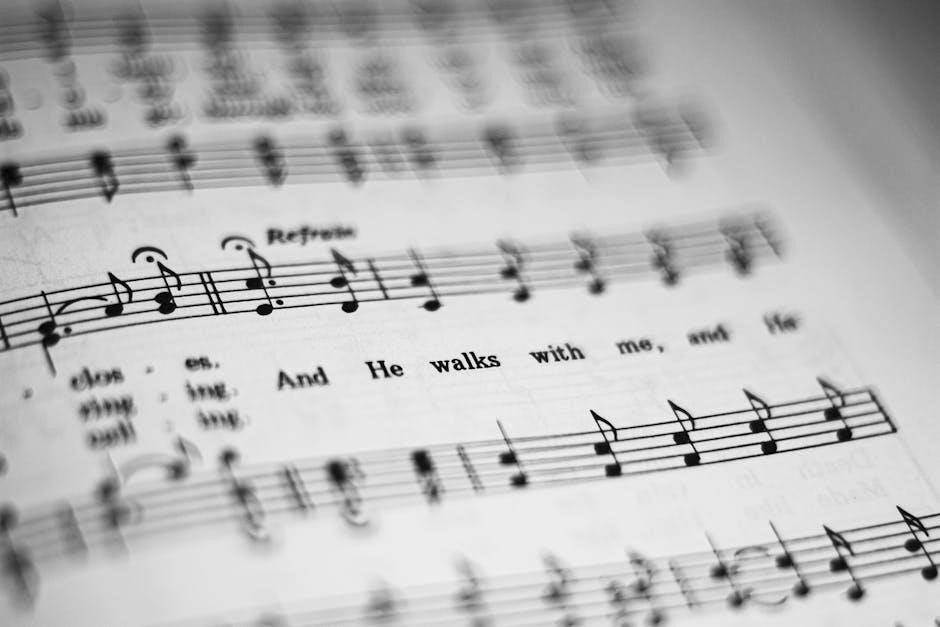O Salutaris Hostia is a revered Eucharistic hymn authored by St. Thomas Aquinas, written for the Feast of Corpus Christi. It is part of the larger hymn Verbum supernum prodiens and holds significant liturgical importance in Catholic worship, particularly during Benediction of the Blessed Sacrament. The hymn praises the Blessed Sacrament and seeks divine strength, reflecting deep theological devotion.
1.1 Historical Background
Written by St. Thomas Aquinas in the 13th century, O Salutaris Hostia is part of the Eucharistic hymn Verbum supernum prodiens, composed for the Feast of Corpus Christi. This hymn reflects Aquinas’ deep devotion to the Blessed Sacrament and was intended for liturgical use. Its origins are rooted in medieval Catholic theology, emphasizing the Real Presence of Christ in the Eucharist. Over time, it has become a cornerstone of Catholic worship, particularly during Benediction and processions, highlighting its enduring spiritual significance.
1.2 Significance in Catholic Liturgy
O Salutaris Hostia holds profound significance in Catholic liturgy, particularly during the Benediction of the Blessed Sacrament and the Feast of Corpus Christi. It is a solemn prayer invoking divine strength and aid, reflecting the deep Eucharistic devotion central to Catholic worship. The hymn’s theological richness and its use in sacred rituals underscore its importance as a liturgical text, fostering reverence and spiritual connection among the faithful during these sacred ceremonies.

Latin Lyrics of “O Salutaris Hostia”
The hymn O Salutaris Hostia is a section of the Eucharistic hymn Verbum supernum prodiens, written by St. Thomas Aquinas. Its Latin lyrics are often paired with Gregorian chant and are central to Catholic liturgical practices, especially during Benediction of the Blessed Sacrament and Corpus Christi celebrations.
2.1 Original Text by St. Thomas Aquinas
The original O Salutaris Hostia text, composed by St. Thomas Aquinas in the 13th century, is a poetic reflection on the Eucharist. It begins with the invocation, O salutáris Hóstia, expressing reverence for the Blessed Sacrament. The hymn, part of Verbum supernum prodiens, was written for the Feast of Corpus Christi, emphasizing the sacrament’s role in granting eternal life. Aquinas’s theological depth and devotion are evident throughout the text, making it a cornerstone of Catholic liturgical music. The Latin text remains a vital part of Eucharistic devotion, cherished for its beauty and spiritual profundity.
2.2 English Translation
The English translation of O Salutaris Hostia captures the hymn’s spiritual essence, rendered as “O saving Victim, open wide the gate of heaven to us below.” Translated by Edward Caswall, it conveys the original Latin’s devotion to the Eucharist. The translation retains the poetic and theological depth of St. Thomas Aquinas’s words, emphasizing the sacrament’s role in granting eternal life. This version is widely used in Catholic liturgy and is often set to music, making it accessible for congregational singing and personal devotion. The hymn’s English form remains a powerful expression of faith and worship.
Musical Notation and PDF Resources
Musical notation and PDF resources for O Salutaris Hostia are widely available, offering free downloads of scores, Latin lyrics, and Gregorian chant arrangements for worship and choir use.
3.1 Free PDF Downloads
Free PDF downloads of O Salutaris Hostia are readily available online, offering musical scores, Latin lyrics, and Gregorian chant notation. These resources are ideal for worship planners, choirs, and personal devotion. Websites provide downloadable files containing the hymn’s melody, harmony, and liturgical instructions. PDFs often include neumes for chant enthusiasts and are compatible with various instruments, making them versatile for both traditional and modern worship settings.
3.2 Musical Scores and Notation
Musical scores for O Salutaris Hostia are widely available, often presented in the traditional Gregorian chant notation. These scores feature neumes, which guide the rhythm and melody, and are typically accompanied by the Latin lyrics. Many arrangements include harmonies suitable for choirs, while others are simplified for congregational singing. The notation is often paired with instrumental accompaniment, enhancing the hymn’s liturgical use. These resources are invaluable for musicians and worship leaders seeking to preserve the hymn’s timeless beauty and sacred purpose.

Liturgical Use and Context
O Salutaris Hostia is primarily sung during the Benediction of the Blessed Sacrament and the Feast of Corpus Christi, highlighting its Eucharistic devotion and solemn worship context.
4.1 Benediction of the Blessed Sacrament
O Salutaris Hostia is traditionally sung during the Benediction of the Blessed Sacrament, a solemn liturgical service. It is often performed toward the end of the service, followed by the Tantum Ergo and the blessing with the Blessed Sacrament. The hymn expresses deep adoration and petition, seeking divine aid and strength amidst life’s challenges. Its Latin text and Gregorian chant notation are widely available in PDF formats, making it accessible for worship planners and choirs to incorporate into this sacred ritual.
4.2 Feast of Corpus Christi
O Salutaris Hostia is integral to the Feast of Corpus Christi, a celebration honoring the Blessed Sacrament. Composed by St. Thomas Aquinas, it is sung during the liturgical procession and Mass, expressing profound reverence for the Eucharist; The hymn’s Latin text and Gregorian melody emphasize the sacrament’s divine significance, making it a cornerstone of Corpus Christi devotion. PDF resources featuring its lyrics and notation are widely available, facilitating its inclusion in worship services worldwide.

Pronunciation Guide
O Salutaris Hostia requires careful Latin pronunciation. Key sounds include “O sa-lu-ta-ris Hostia” (Oh sah-loo-tah-rees Oh-stee-ah). Proper articulation ensures reverent chanting of the hymn.
5.1 Latin Pronunciation Tips
Proper pronunciation of O Salutaris Hostia requires attention to Latin phonetics. Emphasize stressed syllables, such as in “sa-lu-ta-ris” (sah-loo-tah-rees). Vowels are short unless marked, and “Hostia” is pronounced “Oh-stee-ah.” Avoid modern Italian pronunciation; instead, use classical Latin sounds. Practice slow, reverent articulation to honor the hymn’s sacred nature. Listen to Gregorian chant recordings for authentic examples. This ensures the hymn is sung with dignity and theological precision.
5.2 Chant and Melody
The melody of O Salutaris Hostia is traditionally rendered in Gregorian chant, known for its simple yet profound sacred style. The neumes guide the rhythm and pitch, creating a contemplative atmosphere. Sung in unison, it emphasizes unity in worship. Modern arrangements may harmonize the chant, but the essence remains rooted in tradition. The melody complements the hymn’s Eucharistic themes, fostering devotion during liturgical services like Benediction and Corpus Christi. Its soothing cadence enhances the spiritual experience of the congregation.
Hymn Structure and Composition
O Salutaris Hostia features two verses with a simple, meditative structure. Its traditional Gregorian chant style, marked by neumes, supports the Eucharistic themes and liturgical use, enhancing devotion.
6.1 Verse Analysis
O Salutaris Hostia consists of two verses, each conveying profound Eucharistic devotion. The first verse petitions for divine strength against adversity, while the second glorifies the Trinity and seeks eternal life. The hymn’s structure balances supplication and praise, reflecting its liturgical purpose. Its simple yet evocative language, rooted in St. Thomas Aquinas’ theology, underscores the sacramental mystery, making it a cornerstone of Catholic worship and devotion.
6.2 Choral Arrangements
O Salutaris Hostia is often performed as a Gregorian chant, emphasizing its liturgical roots. Choral arrangements range from simple harmonies to intricate polyphony, maintaining the hymn’s sacred essence. Many modern composers have adapted the piece, blending traditional melodies with contemporary styles. The hymn’s versatility allows it to resonate in both intimate and grand worship settings, preserving its spiritual impact while accommodating diverse musical interpretations. Its chant-like structure ensures unity across arrangements, making it a timeless piece in Catholic liturgy.

Author and Composer Information
St. Thomas Aquinas, a 13th-century theologian, authored and composed O Salutaris Hostia for the Feast of Corpus Christi, reflecting deep Eucharistic devotion in Catholic liturgy.
7.1 St. Thomas Aquinas
St; Thomas Aquinas, a Dominican friar and scholastic theologian, composed O Salutaris Hostia in the 13th century. He wrote it as part of the hymn Verbum supernum prodiens for the Feast of Corpus Christi, establishing it as a cornerstone of Eucharistic devotion. Aquinas’s profound theological insights and poetic mastery are evident in the hymn, which remains integral to Catholic liturgy, especially during Benediction of the Blessed Sacrament.
7.2 Modern Composers and Arrangements
Modern composers have reimagined O Salutaris Hostia in various styles, blending tradition with contemporary music. Artists like Dieudonné Duguet and Anthony Werner have created arrangements that maintain the hymn’s sacred essence while appealing to new generations. These compositions are available in PDF formats, offering accessible resources for choirs and worship planners. Such adaptations ensure the hymn’s timeless message endures in diverse musical expressions.

Cultural and Religious Impact
O Salutaris Hostia remains a cornerstone in Catholic liturgy, influencing sacred music and inspiring profound devotion through its timeless Eucharistic hymnody and widespread use in worship.
8.1 Role in Catholic Worship
O Salutaris Hostia holds a central place in Catholic worship, particularly during the Benediction of the Blessed Sacrament and the Feast of Corpus Christi. Its solemn and devotional nature makes it a powerful prayer sung to honor the Eucharist, invoking divine aid and strength. The hymn’s Latin lyrics, rich in theological depth, are often accompanied by traditional Gregorian chant melodies, enhancing its liturgical significance and emotional impact on the faithful.
8.2 Influence on Sacred Music
O Salutaris Hostia has profoundly influenced sacred music, serving as a model for Eucharistic hymns and inspiring numerous compositions. Its theological richness and devotional tone have made it a cornerstone in liturgical music. The hymn’s structure and Latin text, often set to traditional Gregorian chant, have influenced modern composers to create arrangements that preserve its spiritual essence while adapting to contemporary worship styles, ensuring its timeless appeal in Catholic musical traditions.
Comparison with Other Eucharistic Hymns
O Salutaris Hostia stands out among Eucharistic hymns for its profound theological depth and liturgical specificity. Unlike broader Eucharistic hymns, it uniquely focuses on seeking divine strength and aid.
9.1 Similar Themes and Structures
O Salutaris Hostia shares themes of Eucharistic devotion and divine petition with other hymns like Tantum Ergo and Adoro Te Devote. While Tantum Ergo emphasizes the Real Presence, O Salutaris Hostia uniquely combines praise with a plea for strength. Structurally, it follows a similar verse pattern to Verbum supernum prodiens, its parent hymn, but is often performed independently during Benediction. Its concise form and focused prayer make it distinct yet complementary to other Eucharistic hymns.
9.2 Unique Aspects of “O Salutaris Hostia”
O Salutaris Hostia stands out for its concise yet profound expression of Eucharistic devotion. Unlike longer hymns, its brevity and focused prayer make it ideal for specific liturgical moments, such as Benediction; The hymn’s simple, chant-like melody enhances its universality, allowing easy congregational participation. Its structure, derived from St. Thomas Aquinas’ Verbum supernum prodiens, emphasizes petition and praise, making it a unique blend of theology and devotion in Catholic worship.
O Salutaris Hostia remains a cornerstone of Catholic worship, showcasing St. Thomas Aquinas’ profound devotion. Its timeless lyrics and melody continue to inspire Eucharistic reverence globally.
10.1 Summary of Key Points
O Salutaris Hostia, written by St. Thomas Aquinas, is a pivotal Eucharistic hymn. It is part of Verbum supernum prodiens, composed for Corpus Christi. The hymn is integral to Catholic liturgy, especially during Benediction, expressing deep reverence for the Blessed Sacrament. Its Latin lyrics, available in PDF formats, are accompanied by Gregorian chant notation, reflecting its enduring significance in worship and sacred music traditions, inspiring devotion across centuries.
10.2 Final Thoughts on Importance
O Salutaris Hostia remains a cornerstone of Catholic liturgical music, embodying profound spiritual devotion; Its timeless elegance and theological depth continue to inspire worship worldwide. The availability of its PDF resources ensures accessibility for modern congregations, preserving its legacy. As a masterpiece of sacred music, it bridges centuries, connecting believers through its beautiful lyrics and melody, fostering a deeper connection to the Eucharist and Catholic tradition.

Further Resources and References
For additional materials, visit Saint Andrew Catholic Church and other Catholic hymnal websites. They offer free PDF downloads, musical scores, and MIDI files for O Salutaris Hostia.
11.1 Recommended Websites
Visit Saint Andrew Catholic Church for comprehensive resources, including hymnals and service sheets. Catholic Hymn offers a vast collection of Christian hymns with downloadable PDF files. The Cyber Hymnal provides musical scores, MIDI files, and lyrics for worship planning. Additionally, salisburycatholics.org and American Catholic Hymnal are excellent sources for printable scores and sacred music. These websites cater to both individual and communal worship needs, ensuring accessible and enriching liturgical experiences.
11.2 Suggested Reading
For deeper understanding, explore books on Eucharistic hymns, such as “The Hymns of St. Thomas Aquinas” and “Catholic Hymns and Sacred Music.” The American Catholic Hymnal offers extensive insights into liturgical music. Additionally, “Biblical Themes in Classical Music” provides context on religious influences in compositions like O Salutaris Hostia. These resources enrich appreciation for the hymn’s theological and musical significance, available through recommended websites and religious publications.